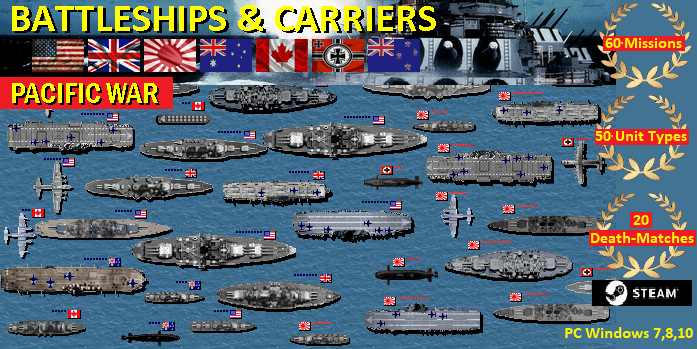USAF Plane
List
USN
FIGHTERS
A-10
Thunderbolt II
F-5 Freedom
Fighter
F-20
Tigershark
F-4 Phantom
II
F-86 Sabre,
A-4 Skyhawk,
A-6 Grumann
Intruder
F-14 Tomcat
F-15 Eagle
F15,
F-16
Fighting Falcon
F-18 Hornet
F-22 Raptor
F-35 Joint
Strike Fighter
U-2 Dragon
Lady
SR-71
Blackbird
F-117
Nighthawk F117
F-22 Raptor,
F-35 Joint
Strike Fighter JSF
B-52
Stratofortress B52
F-111
B-1 Lancer
B-2 Spirit
P-3C Orion
S-3B Viking
CH-46 Sea
Knight,
CH-53 Sea
Stallion
H-3 Sea
King
MH-53 Sea
Dragon
SH-60
Seahawk
HH/UH-1N
Iroquois
AH-1 Cobra
UH-60 Black
Hawk,
HH-60 Pave
Hawk Helicopter
AH-64
Apache AH64
RQ-1
Predator
BATTLESHIP
GAME
World War 2 Edition
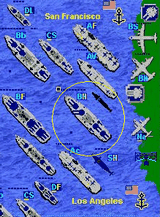 |
Battleship Game
World War 2
PC Win 10/8/7/ XP Download

|
Battleship Game - WW2 Naval
Strategy: the best choice among aircraft carrier games,
submarine and battleship games.
Missions and Scenarios:
Pearl Harbor Game
Atlantic Game 1943
Sink Cruisers Game
Midway Game
Iwo Jima Game
US Marines Game
Luftwaffe Game Pacific
Torpedo Game Boats
Bismarck Game Pacific
Destroy RAF Game
Okinawa
Us Navy Submarine Game
Fleet Submarines Game
Kamikaze Game
U Boat Game
Singapore Game
Swordfish Hunt
Patrol Boats
Air Supremacy
Alert
Battleships Game
Java
Defense
Fleet Cruisers Game
Atlantic Island
Coral Sea Game
Iron Sea
Mykonos
Imperial Ocean
Long Convoy
Skagerrak
Target Los Angeles
West Pacific Game
Pacific War Game
Leyte Transport
Emperor Hirohito
Normandy Game
South Pacific Game
Destroy USAF Game
Submarine Games
US Navy Game
Free Hunt Doenitz Game
Free Hunt Spruance Game
Free Hunt Halsey Game
Imperial Navy I
Royal Navy Game
Free Hunt Pearl Harbor Games
Midway II
Kriegsmarine I
Brisbane Convoy
Clear West Coast
Fall Of Australia
Battle For Leyte
Conquer Of Japan
HMAS Perth
Road To Okinawa
Orange Ports
Emperor Defense
Prince Of Wales
San Bernardino
Pacific Race
Heavy Duty
Tokio Express
Operation Sidney
Bomber Operation
Conquer Of Italy
Heavy Cruiser Game
Frigate Hunt
Santa Cruz
Lamansh Game
Azores Transport
Norway Convoy
Invasion
Grossadmiral
Norway Ports
Drang Nach Ost
Convoy Pk30
Ciano Defense
Sir John Tovey
Free Hunt Andrews
Germans On Pacific
Silent Hunt
Antigua
Return To Midway
Kriegsmarine Game II
Royal Air Force Game
F. Hunt Lancaster
Jamamoto Game
Free Hunt USN
Free Hunt Japan
Free Hunt RAAF
Free Hunt U Boat Game
Free Hunt Aircraft Carriers Game
Free Hunt Hawaii
Free Hunt Yamato Game
Free Hunt Iwo Jima Game
Free Hunt Pacific Game
Free Hunt Torpedos
Free Hunt Convoy
Free Hunt Germany
Free Hunt Germany II
Free Hunt Italy
Free Hunt Malaya
Free Hunt Subs Game
Free Hunt B-29 Game
Free Hunt USN 1944
Devil Island
Dragoon Carriers
|
B52
Bomber (B-52 Stratofortress)
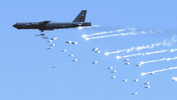
B52 Bomber |
|
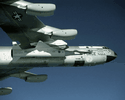
B-52 |
|
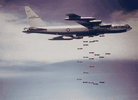
B52 Bombing |
|
|
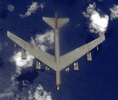
B52 |
|
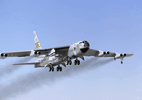
B-52 Landing |
The B52 Stratofortress is an
American military aircraft, a manned strategic bomber
manufactured by Boeing. Often called a Cold War relic,
B-52 still plays a major role in American Airforce
operations.
B52 Mission
Air Combat Command's B-52 is a long-range, heavy bomber
that can perform a variety of missions. The B52 bomber is
capable of flying at high subsonic speeds at altitudes up
to 50,000 feet (15 km). It can carry nuclear or precision
guided conventional ordnance with worldwide precision
navigation capability.
B52 Features
In a conventional conflict, the B-52 can perform
strategic attack, air interdiction, offensive counter-air
and maritime operations. During Operation Desert Storm,
B52 s delivered 40 percent of all the weapons dropped by
coalition forces. It is highly effective when used for
ocean surveillance, and can assist the U.S. Navy in
anti-ship and mine-laying operations. Two B-52s, in two
hours, can monitor 140,000 square miles (364,000 square
kilometers) of ocean surface.
All B-52s are equipped with an
electro-optical viewing system that uses platinum
silicide forward-looking infrared and high resolution
low-light-level television sensors to augment targeting,
battle assessment, and flight safety, thus further
improving its combat ability and low-level flight
capability.
B52 Pilots wear night vision goggles (NVGs) to enhance
their vision during night operations. Night vision
goggles provide greater safety during night operations by
increasing the pilot's ability to visually clear terrain,
avoid enemy radar and see other aircraft in a
covert/lights-out environment.
Starting in 1989, on-going modifications incorporates the
Global Positioning System, heavy stores adapter beams for
carrying 2,000 pound munitions, and a full array of
advanced weapons currently under development.
The use of aerial refueling gives the B52 a range limited
only by crew endurance. It has an unrefueled combat range
in excess of 8,800 miles (14,080 kilometers).
| CIA / KGB Operation
Game.
Run your own intelligence game. Travel around the
world and set up espionage game, trade with state
secrets, weapon systems, spy codes, WMD, hire
secretaries, agents, lawyers and soldiers,
establish secret agent stations, cells and bases
and search for criminals and politicians. Involve
in agent game. Game contains more than 40
missions including Nuclear Game, Cold War Game,
Secret Agent, CIA Games, USAF, Prime Minister,
RAF, Bin Laden, Sadam, KGB, Operations Iran… |
|
The aircraft's flexibility was
evident in Operation Desert Storm and again during
Operation Allied Force. B-52s struck wide-area troop
concentrations, fixed installations and bunkers, and
decimated the morale of Iraq's Republican Guard. The
Persian Gulf War involved the longest strike mission in
the history of aerial warfare when B-52s took off from
Barksdale AFB, Lousiana, launched conventional air
launched cruise missiles and returned to Barksdale -- a
35-hour, non-stop combat mission. During Operation Allied
Force, B-52s opened the conflict with conventional cruise
missile attacks and then transitioned to delivering
general purpose bombs and cluster bomb units on Serbian
army positions and staging areas.
B52 Background
For more than 40 years B-52 Stratofortresses have been
the backbone of the manned strategic bomber force for the
United States. The B-52 is capable of dropping or
launching the widest array of weapons in the U.S.
inventory. This includes gravity bombs, cluster bombs,
precision guided missiles and Joint Direct Attack
Munitions. Updated with modern technology the B52 will be
capable of delivering the full complement of joint
developed weapons and will continue into the 21st century
as an important element of the U.S.'s military
capabilities. Current engineering analyses show the
B-52's life span to extend beyond the year 2045.
The B-52 A first flew in 1954, and the B model entered
service in 1955. A total of 744 B52s were built with the
last, a B-52 H, delivered in October 1962. Only the H
model is still in the Air Force inventory and is assigned
to Air Combat Command and the Air Force Reserves.
The first of 102 B-52H's was delivered to Strategic Air
Command in May 1961. The H model can carry up to 20 air
launched cruise missiles. In addition, it can carry the
conventional cruise missile that was launched in several
contingencies during the 1990s, starting with Operation
Desert Storm and culminating with Operation Allied Force.
The B52 contributed to the U.S. success in Afganistan,
providing the ability to loiter high over the battlefield
and provide Close Air Support (CAS) through the use of
precision guided munitions. The long range and endurance
of the B52 provided a U.S. presence unmatched by any
other combat aircraft. B-52's also played a key role in
the second Gulf War in 2002-2003. During Operation Iraqi
Freedom B52 Stratofortress bombers provided Close Air
Support and bombing leading to the toppling of the Iraqi
regime of Saddam Hussein.
B52 General characteristics
Primary Function: Heavy bomber
B52 Contractor: Boeing Military Airplane Co.
Power plant: Eight Pratt and Whitney engines TF33-P-3/103
turbofan
B52 Thrust: Each engine up to 17,000 pounds
Length: 159 feet, 4 inches (48.5 meters)
B52 Height: 40 feet, 8 inches (12.4 meters)
Wingspan: 185 feet (56.4 meters)
B52 Speed: 650 miles per hour (Mach 0.86)
Ceiling: 50,000 feet (15,151.5 meters)
B52 Weight: Approximately 185,000 pounds empty (83,250
kilograms)
Maximum Takeoff Weight: 488,000 pounds (219,600
kilograms)
B52 Range: Unrefueled 8,800 miles (7,652 nautical miles)
Armament: Approximately 70,000 pounds (31,500 kilograms)
mixed ordnance -- bombs, mines and missiles. (Modified to
carry air-launched cruise missiles, AGM-84 Harpoon
anti-ship and AGM-142 Have Nap missiles.)
Crew: Five (aircraft commander, pilot, radar navigator,
navigator and electronic warfare officer)
Accommodations: Six ejection seats
B52 Unit Cost: $74 million
Date Deployed: February 1955
Inventory: Active force, 85; ANG, 0; Reserve, 9
Among its crew, the B-52 is affectionately known as the
"BUFF", an acronym for "big ugly fat
fucker" (or "big ugly fat fellow").
The B-52 went through several
design changes and variants over its 10 years of
production.[3]
B-52 A
Only three of first production version, the B-52A, were
built, all loaned to Boeing for flight testing.[21] The
first production B-52A differed from prototypes in having
redesigned forward fuselage. The bubble canopy and tandem
seating was replaced by a side-by-side arrangement and a
21 inch (53 cm) nose extension accommodated more avionics
and a new 6th crew member.[63] In the rear fuselage a
tail turret with four 0.50 inch (12.7 mm) machine guns
with a fire-control system, and a water injection system
to augment engine power with a 360 US gallon (1,363 L)
water tank was added. The aircraft also carried a 1,000
US gallon (3,785 L) external fuel tank under each
wing.[63] The tanks acted as dampeners to reduce wing
flex and also kept wingtips close to the ground for ease
of maintenance.
N B52 A
The last B-52A (serial 52-0003) was modified and
redesignated N B-52 A in 1959 to carry the North American
X-15 at a cost of US$2 million. A pylon was fitted under
the right wing between the fuselage and the inboard
engines with a 6 feet x 8 feet (1.8 m x 2.4 m) section
removed from the right wing flap to fit the X-15 tail.
Liquid oxygen tanks were installed in the bomb bays to
refuel the X-15 before launch. First flight with X-15 was
on 10 March 1959, and NB-52A carried the X-15 on 59 of
the program's 199 flights.
Converted RB-52B to B-52B Balls 5 at Wings Museum.
Converted RB-52B to B-52B Balls 5 at Wings Museum.
B-52B/ R B52 B
The B-52B was the first version to enter service with the
USAF on 29 June 1955, with the 93rd Bombardment Wing at
Castle AFB in California. This version included minor
changes to engines and avionics, in the attempt to fix
minor problems. Temporary grounding of the aircraft in
February 1956, after a crash, and the following July,
caused training delays, and at mid-year there were still
no combat-ready B-52 crews.[30]
Of the 50 B52 Bs built, 27 were capable of carrying a
reconnaissance pod as RB-52Bs (the crew was increased to
eight in these aircraft).[21] The 300 pound (136 kg) pod
contained radio receivers, a combination of K-36, K-38
and T-11 cameras, and two operators on downward-firing
ejection seats. The pod required only four hours to
install.[30]
Seven B52 Bs were brought to B-52C standard under Project
Sunflower.[30]
N B52 B
The NB-52B was B-52B number 52-0008 converted to an X-15
launch platform at a cost of US$2 million. It
subsequently flew as the "Balls 8" in support
of NASA research until 17 December 2004, making it the
oldest flying B-52B. It was replaced by a modified
B-52H.[64]
B-52 C
In the B-52C the fuel capacity (and range) was increased
to 41,700 US gallons by adding larger 3000 US gallon
underwing fuel tanks. The gross weight was increased by
30,000 pounds (13,605 kg) to 450,000 pounds. The belly of
the aircraft was painted with antiflash white paint,
which was intended to reflect thermal radiation away
after a nuclear detonation.[65]
RB-52 C
The RB-52C was the designation given, but seldom used, to
B-52Cs converted for reconnaissance duties in a similar
manner to RB-52Bs.[65]
B-52 D
The B-52D was a dedicated long-range bomber without a
reconnaissance option. The Big Belly modifications
allowed the B52 D to carry heavy loads of conventional
bombs for carpet bombing over Vietnam. Aircraft assigned
to Vietnam were painted camouflage with black bellies to
defeat searchlights.[66]
B-52 E
In the B-52E the aircraft had an updated avionics and
bombing navigational system, which was eventually
debugged and included on following models.[67]
One E aircraft (number 56-0631) modified as a testbed for
various B-52 systems at a cost of US$6.02 million.
Redesignated NB-52E, the aircraft was fitted with canards
and a Load Alleviation and Mode Stabilization system
(LAMS) which reduced airframe fatigue from wind gusts
during low level flight. In one test, the aircraft flew
10 knots (11.5 mph, 18.5 km/h) faster than the never
exceed speed without damage because the canards
eliminated 30% of vertical and 50% of horizontal
vibrations caused by wind gusts.[67][68]
B52 F
In the B-52F, the aircraft was given J57-P-43W engines
with a larger capacity water injection system and new
alternators.[69] The aircraft a problem with fuel leaks,
which were eventually solved by service modifications
Blue Band, Hard Shell, and QuickClip.[53]
B-52 G
The B-52G was proposed to extend the B-52's service life
during delays in the B-58 Hustler program. At first, a
radical redesign was envisioned with a completely new
wing and Pratt & Whitney J75 engines. This was
rejected to avoid slowdowns in production, although
changes were implemented. The most significant of these
was the brand new "wet" wing with integral fuel
tanks which considerably increased the fuel capacity
— gross aircraft weight went up by 38,000 pounds
(17,235 kg) compared with prior variants. In addition, a
pair of 700 US gallons (2,650 L) external fuel tanks was
fitted under the wings. The wing also had the traditional
ailerons eliminated, instead utilizing spoilers for roll
control. The tail fin was shortened by 8 feet (2.4 m),
water injection system capacity was increased to 1,200 US
gallons (4,540 L), and the nose radome was enlarged. The
tail gunner was provided with an ejection seat and moved
to the main cockpit. Dubbed the "Battle
Station" concept, the offensive crew (pilot,
copilot, and the two bombing navigation system operators
on the lower deck) faced forward, while the defensive
crew (gunner and ECM operator) on the upper deck faced
aft. The B-52G entered service 13 February 1959 (a day
earlier, the last B-36 was retired, making SAC an all-jet
bomber force). Nearly all B-52Gs were destroyed in
compliance with the Strategic Ams Reduction Treaty START
I of 1992. A few examples remain in museums and as static
displays at various air force bases.
B52 H
The B52 H had the same crew and structural changes as the
B-52G. The most significant upgrade was the switch to
TF33-P-3 turbofan engines which, despite the initial
reliability problems (corrected by 1964 under the Hot Fan
program), offered considerably better performance and
fuel economy than the J57 turbojets. The ECM and avionics
were updated, a new fire control system was fitted, and
the rear defensive armament was changed from machine guns
to a 20 mm M61 Vulcan cannon. A provision was made for
four AGM-48 Skybolt ballistic missiles. First flight 10
July 1960, entered service 9 May 1961. This is the only
variant still operational.
A total of 744 B-52s were built. The last production
aircraft, B-52H number 61-0040, left the factory on 26
October 1962.
B-52 Museum and Static
Displays
* B-52 A 52-003 & B-52D Pima Air & Space Museum,
Tucson, Arizona
* R B52 B 52-005 Wings Over the Rockies Air and Space
Museum closed Lowry AFB, Denver, Colorado
* R B52 B 52-008 Edwards AFB Museum, California
* B-52 B 52-0013 National Atomic Museum
* B-52 B 52-8711 Strategic Air & Space Museum[3]
Ashland, Nebraska
* B-52 D 55-0057 Static display Maxwell AFB Alabama
* B-52 D 55-0062 K.I. Sawyer Heritage Air Museum[4]
former K.I. Sawyer AFB Michigan
* B-52 D 55-0068 Static display Lackland AFB Texas
* B-52 D 55-0071 USS Alabama (BB-60) Battleship Memorial
Park[5] Mobile, Alabama
* B52 D 55-0083 Static display USAF Academy Colorado
* B-52 D 55-0085 Museum of Aviation Robins AFB Georgia
* B-52 D 55-0094 Kansas Aviation Museum[6] Wichita,
Kansas
* B-52 D 55-0105 War Service Memorial Seoul South Korea
* B-52 D 55-0677 Yankee Air Museum near Willow Run
Airport in Ypsilanti, Michigan
* B-52 D 55-0679 March Field Air Museum next to March Air
Reserve Base, Riverside, California
* B52 D 56-0585 Air Force Flight Test Center Museum
Edwards AFB California
* B-52 D 56-0586 Arc Light Memorial - Static display
Andersen AFB Guam
* B-52 D 56-0589 Static display Sheppard AFB Texas
* B52 D 56-0612 Castle Air Museum near Atwater,
California
* B-52 D 56-0629 & B-52G 57-6509 Eighth Air Force
Museum Barksdale AFB Louisiana
* B52 D 56-0657 South Dakota Air & Space Museum
Ellsworth AFB Rapid City, South Dakota
* B-52 D 56-0659 Static display Davis-Monthan AFB Arizona
* B-52 D 56-0665 National Museum of the United States Air
Force Dayton, Ohio
* B52 D 56-0676 Armed Forces & Aerospace Museum
Fairchild AFB Washington
* B52 D 56-0683 Static display Whiteman AFB Missouri
* B-52 D 56-0685 Static display Dyess AFB Texas
* B-52 D 56-0687 Orlando International Airport (Former
McCoy AFB)- Static display Orlando, Florida
* B-52 D 56-0689 Imperial War Museum Duxford, Duxford,
England
* B-52 D 56-0692 Kelly Field Heritage Museum - Static
display Kelley AFB Texas
* B52 D 56-0695 Static display Tinker AFB Oklahoma
* B52 D 56-0696 Travis Air Museum[7], "Twilight
D'Lite" Travis AFB California
* B-52 F 57-0038 Being relocated to Palmdale Airpark,
Palmdale, California
* B-52 G 57-6468 Static display Offutt AFB Nebraska
* B-52 G 58-0185 Air Force Armament Museum Eglin AFB
Florida
* B52 G 58-0191 Hill Aerospace Museum Hill AFB Utah
* B52 G 58-0225 Griffiss AFB Museum Rome, New York
* B-52 G 58-0232 Static display Offutt AFB Nebraska
* B-52 G 59-2577 Heritage Center in Grand Forks AFB North
Dakota
* B-52 G 59-2584 Museum of Flight Seattle, Washington
* B52 G 59-2596 Australian Aviation Heritage Center
Darwin, Australia
* B-52 G 59-2601 Memorial Park - Static display Langley
AFB Virginia
Credits: USAF
|
A strategic bomber is a heavy type
aircraft designed to drop large amounts of ordnance onto
a distant target for the purposes of debilitating an
enemy's capacity to wage war. Unlike tactical bombers,
which are used in the battle zone to attack troops and
military equipment, strategic bombers are built to fly
into an enemy's heartland to destroy strategic targets
e.g. major military installations, factories and cities.
In addition to strategic bombing, strategic bombers can
be used for tactical missions. Only 3 countries maintain
nuclear bombers: US, Russia and China.
| |
 |
 |
| Turn-based WW2
naval game, extension to the classic
Submarine game (Battleship game) where
ships/planes/subs can move. Contains plenty of
game missions, game campaigns and 40 ship,
submarine, airplane ana port artillery types,
with combat maps up to 96X96 large. |
| |
| |
|
Guns Girls
Lawyers Spies is a turn-based strategy trade
management game. You'll build your
multinational spy company, destroy competition,
hire employees, spies, and businessman, establish
spy cells, bases and objects.
There is a more than 40 missions with different
game objectives |
| |
| |
| |
|
Tycoon Strategy Game - build
your own world business empire as an arms dealer
tycoon. Travel around the world, trade with more
than 400 weapon systems, hire secretaries,
bodyguards, lawyers, fighters and tanks,
establish companies and search for criminals and
hostages.
(Free download for Win 10, 8, 7, XP) |
| |
| |
|
|
| |
|
|
| |
|
|
| |
Turn-based
trade strategy game. Build your
own world empire as an arms dealer.
Trade with weapons, hire spies, agents,
secretaries, bodyguards and lawyers, and
establish bases and spy cells worldwide.
Trading cards game combat system included.
|
|
During the
Cold War the U.S. and United Kingdom on one side and the
USSR on the other kept nuclear-armed strategic bombers
ready to launch at a moment's notice as part of the
deterrent strategy of Mutual Assured Destruction. Most
strategic bombers of the two superpowers were designed to
deliver nuclear weapons. For a time, B-52 Stratofortress
bombers were kept in the air around the clock, orbiting
fail-safe points near the Soviet border. The RAF's
V-bombers were directed against targets in European
Russia and would have been able to reach and destroy
cities like Kiev or Moscow before US bombers.
More recent strategic bombers like the Rockwell
International (now Boeing) B-1B Lancer bomber, Tupolev
Tu-160 Blackjack and the Northrop Grumman B-2 Spirit
bomber incorporate stealth features in their design in an
effort to avoid detection. Non-stealthy strategic
bombers, e.g., the venerable Boeing B-52 Stratofortress
or the equally venerable Tupolev Tu-95 are still relevant
through the use of air-launched cruise missiles and other
"stand-off" weapons like JSOW and JDAM. Indeed,
it is likely that the USAF B-52 fleet will, with
continuing upgrades, outlive the B-1B fleet. However, the
USAF has recently launched a program for a new strategic
bomber to complement the current fleet; it is likely that
this bomber will also serve as a replacement for both the
B-52 and B-1. In the case of the Russian VVS (Air
Forces), new Tu-160 strategic bombers are expected to be
delivered on a regular basis over the course of the next
10-20 years. Additionally, the current Tu-95, Tu-142,
Tu-26 and Tu-160 fleet will be periodically updated, as
it was seen in the 1990s with the Tu-22M fleet.
USAF B-1 Lancer supersonic strategic bomber
During the Cold War, strategic bombers were almost
certainly armed with nuclear weapons. However, since the
end of the Cold War, strategic bombers have exclusively
been deployed using non-nuclear, conventional weapons.
During Operation Desert Storm, the invasion of
Afghanistan, and the 2003 invasion of Iraq, American
B-52s and B-1s were employed in both strategic and
tactical roles. During the 1979-1988 Soviet-Afghan war,
many Tu-95 carried out several mass bombings on several
regions of the country.
* United Kingdom Avro Vulcan (21,000 lb)
* United States B-36 Peacemaker (72,000 lb)
* United States B-45 Tornado (22,000 lb)
* United States B-47 Stratojet (25,000 lb)
* United States B-50 Superfortress (28,000 lb)
* United States B-52 Stratofortress (60,000 lb)
* United States B-58 Hustler (19,450 lb)
* France Dassault Mirage IV (3,000 lb)
* United States FB-111A, a nuclear capable variant of the
F-111 'Aardvark'
* United Kingdom Handley Page Victor
* Soviet Union Myasishchev M-4 (52,910 lb)
* Soviet Union Tupolev Tu-4, reversed engineered version
of B-29 Superfortress (Also used by People's Republic of
China)
* Soviet Union Tupolev Tu-16 (20,000 lb)
* Soviet Union Tupolev Tu-95 (33,000 lb)
* Soviet Union Tupolev Tu-22M (46,300 lb)
* United Kingdom Vickers Valiant
* People's Republic of China Xian H-6 (Licenced copy of
Soviet Union Tupolev Tu-16)
* United States B-1 Lancer (75,000 lb)[3]
* United States B-2 Spirit (50,000 lb)
* United States B-52 Stratofortress (60,000 lb)
* Russia Tupolev Tu-22M (46,300 lb)
* Russia Tupolev Tu-95 (33,000 lb)
* Russia Tupolev Tu-160 (88,200 lb)
* People's Republic of China Xian H-6 (Licenced copy of
Soviet Union Tupolev Tu-16)
B-52 Bomber Weapons Bay Launchers
Six of the U.S. Air Force’s B-52 bombers can now
take flight with a greater variety of weapons, thanks to
enhanced internal weapons bay launchers delivered by
Boeing [NYSE: BA]. The upgraded launchers allow the B-52
to carry GPS-guided or “smart” weapons in the
weapons bay for the first time and are ready for use.
“The upgrades to the B-52 bomber’s internal
weapons bay have made it possible to have zero gap on the
bomber’s long-range bombing capabilities as we
transfer from Conventional Air Launched Cruise Missiles
to Joint Air-to-Surface Standoff Missile – Extended
Range,” said Col. Tim Dickinson, B-52 Program
Director with the U.S. Air Force.
The enhancement modifies an existing common strategic
rotary launcher in the internal weapons bay into a
conventional rotary launcher and increases the total
number of smart weapons the B-52 can carry and deliver,
giving crew members greater flexibility to adapt to
changing conditions on the battlefield.
The launchers, which can be moved from one bomber to
another, can carry, target and launch eight Joint Direct
Attack Munitions. Future increments of the weapons bay
launcher upgrade program will add the capability to carry
Joint Air-to-Surface Stand Off Missiles and Miniature Air
Launched Decoys.
“With this added capability, the B-52 bomber will
remain relevant for decades to come,” said Jeff
Lupton, Boeing’s B-52 Internal Weapons Bay Upgrade
program manager. “Our commitment to providing our
USAF customer with uncompromising service enabled us to
successfully deliver these launchers on an accelerated
schedule.”
These deliveries follow several months of successful
ground and flight testing of the launchers and support
the U.S. Air Force’s accelerated schedule to
complete the first stage of the upgrade program –
low rate initial production.
The nation’s entire B-52 bomber fleet will soon be
equipped with technology that greatly enhances the
aircraft’s combat capabilities in the digital
battlespace. The U.S. Air Force on August 28 awarded
Boeing [NYSE: BA] a contract for B-52 bomber Combat
Network Communications Technology, known as CONECT.
The new CONECT contract will bring capability to the
entire fleet. Boeing and the Air Force worked closely
under urgent deadlines to complete contract negotiations
in time for upgrades to continue uninterrupted.
“The multifunction, critical capability that CONECT
provides for the B-52 was at risk for missing kit
installation schedule. Boeing and the Air Force's
collaborative effort to reduce the kit contracting
process by 50 percent paved the way to deliver on-time,
quality war-fighting capabilities. Parallel efforts,
which required early participation, communication and
coordination from Boeing, sub-tier suppliers, DCAA and
DCMA were key in making CONECT a success!” said
Renee Sauerland, B-52 CONECT project manager for the Air
Force.
Boeing’s CONECT modernizes communication systems for
the B-52 bombers with enhancements that keep the bombers
in flight.
“Each B-52 bomber comes in for program depot
maintenance once every four years, and CONECT is
installed at that time. We have delivered all previously
contracted kits to the Air Force but needed to get
additional kits on contract so upgrades could continue on
every bomber that comes through – once you miss an
aircraft, it is four years before you have another
opportunity to touch it. I’m proud of the Boeing
team and thankful for our cooperative relationship with
the customer that allowed us to complete negotiations so
that the remainder of the fleet will receive
CONECT,” said Scot Oathout, B-52 program director
for Boeing.
The B52 bomber was built during the Cold War, but CONECT
provides 21st century digital capabilities that give the
bomber the agility and flexibility needed for the modern
battlefield.
|
